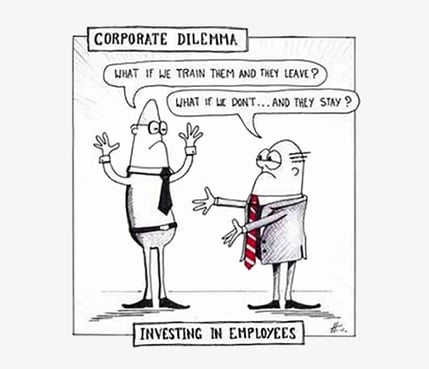5 min read

Employees are continuing to contemplate whether they should consider jumping ship, as turnover rates steadily sweep the U.S.
|
Key Takeaways
|
95% of American workers are thinking of quitting their job, according to a June 2021 survey from job site Monster.com. The top reasons? Burnout and lack of growth opportunities. [1]
So, what changes can you implement in your business now to prevent this type of employee loss from occurring (and dealing with the high costs of turnover in the future)?
Start by revisiting your human capital management strategy to make sure you're cultivating a positive workplace culture that meets all of your employees' needs.
Then, aligning your human capital management strategy with your financial management strategy will help you create a data-driven, goal-based workplace that fosters fulfillment with opportunity, recognition, and rewards
What Employee Turnover Is Actually Costing You
Once you add up all the direct and indirect expenses associated with losing employees and their expertise, advertising job openings, filling positions, training and waiting out the low-productivity period of onboarding required for a new employee to get up to speed, the true cost of employee turnover is likely higher than you realize.
Read More: More Than You Think: The Cost Of Employee Turnover.
The Society for Human Resource Management (SHRM) estimates the average cost of replacing salaried employees is approximately 6 to 9 months’ salary. If an employee earns $60,000 per year, that totals to a $30,000 to $45,000 loss (in training and recruiting expenses). Now, imagine losing a quarter of your employees at once. [2]
How much would it cost you? How much would productivity lag? How would your bottom line be affected?
What Maslow's Hierarchy of Needs Can Teach Business Leaders About Human Capital Management
The famous hierarchical pyramid of needs outlined by Maslow has a lot to offer business leaders when it comes to managing, satisfying, and motivating employees and designing the type of workplace that people never want to leave.
From bottom to top, Maslow's hierarchy of needs starts with the most basic of human needs (physiological and security) and builds upward to more spiritual, lofty goals (love and belonging, self esteem, and self-actualization).
Maslow's basic principles state that a person cannot strive for higher needs until the more basic needs have been met. For example, a person must worry about obtaining food, clothing, shelter, and safety before they can be concerned with belonging, feeling confident, or challenging themselves on a higher level.
The same principles apply to employee engagement in the workplace. You can meet your employees' most basic needs by offering fair monetary compensation (physiological needs) and a reasonable amount of job security (safety).
In the workplace, creating a positive culture that fosters team building, support, encouragement, and alignment around common goals will provide your employees with the next tier of needs, a sense of belonging. You can further generate this sense of connectedness among your employees and the community by engaging your business in volunteer efforts and community outreach projects.
Rewarding and recognizing achievements and conversely viewing failures as opportunities for learning, creates a positive environment that will foster self-esteem. You'll help create confident employees who know their talents but also aren't afraid to take measured risks with the goal of learning, growing, and improving.
Self-actualization occurs in the workplace when employees are given the power to take their career development into their own hands. Providing clear pathways for career growth, professional challenges, and opportunities for creativity and learning will help your employees feel self-actualized and spiritually fulfilled within their roles in your company.
Meet More of Your People's Needs by Encouraging Personal Development
You've likely heard the saying, "People don't quit jobs; they quit bosses."
Assuming you're a good boss and have appointed the right individuals to fill leadership positions throughout your company, why else might employees decide to quit?
Read More: The Cost of Bad Leadership: How To Choose The Right Leaders For Your Business
Career growth and professional development plays a vital role in employee happiness. 29% of Monster.com respondents attributed the factor driving job change to be the lack of growth opportunities at their current company. Another Prudential survey found that 80% of workers planning to quit their jobs report being concerned about their career growth. [3]

Source: https://medium.com/ecubed-training/corporate-dilemma-1c7a03546927
The obvious solution to this problem is to build career development opportunities into your workplace. Don't wait for an employee to complain that they are not being challenged. Instead, actively challenge your employees with a bottom-up approach to management, idea generation, and more.
As outlined by Maslow's Hierarchy of Needs, helping your employees feel self-actualized through career development could improve employee retention. You can provide your employees with opportunities for self-actualization in the workplace by offering challenging positions, opportunities for career development and advancement, training and education, and by leveraging a growth mindset that encourages creativity and learning.
Use Budgets and Cascading Goals, Plus Rewards and Recognition to Align Strategies and Create a Team
Your financial management and human capital management strategies will be truly aligned when you start setting benchmarks to meet larger goals and begin budgeting for recognition and rewards for employee achievements.
Strategic benchmarks and goals provide your employees with a clear picture of their roles and responsibilities, and they also provide you with the opportunity to create a positive culture in the workplace that meets a variety of your employee's emotional needs. As employees meet their goals or go above and beyond expectations, it's essential to both recognize and reward their achievements.
Read More: The Amazing ROI Of Recognition, Rewards, Retention, And Engagement.
At GrowthForce, for example, we've implemented a fun, collaborative system of recognition and reward that achieves both simultaneously. With a specified “kudos” company email, employees are encouraged to recognize and report coworkers whose actions are in line with our company's core values. When employees exceed expectations, their coworkers can submit their names and achievements to the email, then at the end of each quarter, two winners are drawn from the names, and both the submitter and submitted, have the chance to win a substantial monetary gift.
When the strategies coming from your financial department and human resources department work hand-in-hand by establishing cascading goals throughout your company, you'll see improved employee retention, increased productivity, and a return on investment that directly boosts your bottom line.
[1] https://learnmore.monster.com/job-index-in-the-time-of-coronavirus
[3] https://news.prudential.com/presskits/pulse-american-worker-survey-is-this-working.htm

.png?width=2000&height=440&name=Transitional%20GF%20Logo%20-%20Transparent%20(1).png)


![How People Drive Profit [GUIDE] 6 Key Company and People KPIs you need to make Data-Driven Decisions...](https://no-cache.hubspot.com/cta/default/549461/a4c91ab8-e371-4c8a-b4dd-8bd96d5105f0.png)
